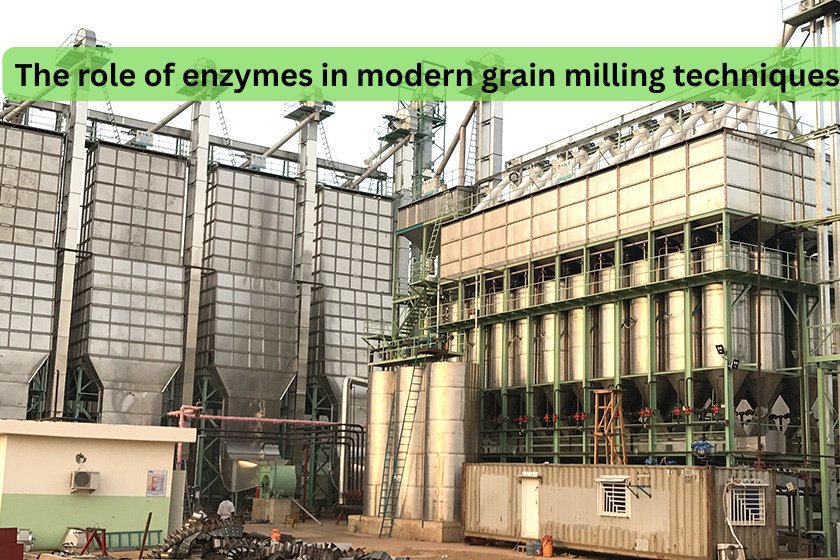Enzymes play a pivotal role in modern grain milling techniques by enhancing processing efficiency, improving product quality, and enabling the production of specialized flours and grain-based products. Their targeted biochemical action allows mills to achieve specific functional and nutritional goals while reducing reliance on chemical additives. Here’s how enzymes are used in modern grain milling:
1. Enhancing Dough Performance
- Role of Enzymes:
- Amylases: Break down starch into sugars, providing fermentable substrates for yeast in bread-making.
- Proteases: Modify gluten proteins to improve dough extensibility and handling.
- Xylanases: Degrade arabinoxylans (hemicellulose) to increase water absorption and dough stability.
- Benefits:
- Improved dough consistency and machinability.
- Enhanced bread volume and crumb texture.
- Better water retention in baked goods.
- Example: Enzymes are added during milling to produce flours specifically designed for high-volume bread production.
2. Increasing Milling Yield
- Role of Enzymes:
- Amylases and Proteases: Break down endosperm components, facilitating the separation of bran and germ.
- Lipases: Break down lipids that may cause flour rancidity, extending shelf life.
- Benefits:
- Higher extraction rates of usable flour.
- Improved separation efficiency during milling.
- Reduced waste in the milling process.
- Example: Enzyme-treated wheat yields more fine flour and less bran contamination.
3. Improving Nutritional Value
- Role of Enzymes:
- Phytases: Break down phytic acid, increasing the bioavailability of minerals like iron, zinc, and calcium.
- Beta-Glucanases: Degrade beta-glucans in grains like barley and oats, making them more digestible.
- Benefits:
- Enhanced nutritional profiles of flour and grain-based products.
- Better appeal to health-conscious consumers.
- Example: Flour enriched with phytase-treated wheat improves mineral absorption in end consumers.
4. Supporting Gluten-Free Milling
- Role of Enzymes:
- Transglutaminases: Improve protein networks in gluten-free dough by cross-linking proteins.
- Amylases and Cellulases: Enhance the texture and moisture retention in gluten-free baked goods.
- Benefits:
- Better texture and elasticity in gluten-free products.
- Increased consumer acceptance of gluten-free alternatives.
- Example: Enzymes enable the production of high-quality rice or millet flour suitable for gluten-free bread and pasta.
5. Reducing Energy Consumption
- Role of Enzymes:
- Enzymes like amylases and proteases facilitate easier grinding by softening grain kernels.
- Benefits:
- Lower energy requirements during the milling process.
- Reduced wear and tear on milling equipment.
- Example: Pretreating grains with enzymes minimizes the mechanical effort required for milling.
6. Extending Shelf Life
- Role of Enzymes:
- Lipase Inhibitors: Prevent lipid oxidation, which causes rancidity in whole-grain flours.
- Amylases: Slow retrogradation of starch, maintaining softness in baked goods.
- Benefits:
- Prolonged freshness of flours and grain-based products.
- Reduced food waste and higher consumer satisfaction.
- Example: Whole wheat flours treated with lipase inhibitors retain freshness longer.
7. Enhancing Functional Properties
- Role of Enzymes:
- Oxidases: Strengthen gluten networks, improving dough elasticity.
- Lipoxygenases: Bleach flour naturally, enhancing its whiteness.
- Benefits:
- Customization of flour for specific applications (e.g., pastry, bread, or biscuits).
- Replacement of chemical additives with natural enzyme solutions.
- Example: Specialty flours for puff pastries often include oxidases for better layering properties.
8. Supporting Specialty Flour Production
- Role of Enzymes:
- Amylases and Proteases: Modify starch and protein content in flours for specific uses like pizza dough or cake.
- Xylanases: Increase water absorption in high-fiber flours, improving their processing behavior.
- Benefits:
- Enables the production of tailored flours for diverse applications.
- Satisfies demand for high-performance flours in specialized industries.
- Example: Enzyme-treated rye flour is optimized for sourdough bread production.
9. Facilitating Bioprocessing
- Role of Enzymes:
- Cellulases and Hemicellulases: Break down non-starch polysaccharides for bioethanol production.
- Amylases: Hydrolyze starch into glucose for fermentation processes.
- Benefits:
- It adds value to by-products like bran or germs through bioethanol production.
- Supports the circular economy in grain milling.
- Example: Bran treated with cellulases is converted into fermentable sugars for industrial uses.
10. Enhancing Sustainability
- Role of Enzymes:
- Enable more efficient processing with less water and energy.
- Reduce the need for chemical additives, lowering the environmental impact.
- Benefits:
- Greener production processes with reduced carbon footprints.
- Aligns with consumer and regulatory demands for sustainable practices.
- Example: Mills using enzymatic processes report lower energy and chemical usage.
Challenges in Using Enzymes in Grain Milling
- Cost: High-quality enzymes can be expensive, requiring careful cost-benefit analysis.
- Process Optimization: Enzymes must be carefully calibrated to avoid overprocessing or undesired side effects.
- Storage and Stability: Enzymes require specific storage conditions to retain activity, increasing logistical complexity.
- Consumer Perception: While natural, some consumers may resist products with enzymatic modifications unless clearly explained.
Conclusion
Enzymes are integral to modern grain milling, offering a natural and efficient way to enhance product quality, optimize processes, and meet the demands of diverse markets. By leveraging enzymes strategically, mills can produce superior flours tailored to specific applications, reduce energy use, and support sustainability initiatives. As enzyme technology advances, its role in the milling industry is set to grow even further, enabling innovation and efficiency across the value chain.
Hashtags
#InnovativeMilling #EnzymeRevolution #EfficientGrainProcessing #SustainableFoodProduction #MillingAdvancements #EnzymeEnhancedFood #NextGenMilling #RevolutionizingFoodProcessing #SmartGrainMilling #EnzymeDrivenMilling #ModernFoodTech #SustainableGrainProcessing #EnzymeInnovation #MillingSolutions #FoodIndustryInnovations #EnzymeEfficiency #GrainProcessingRevolution #FutureOfFoodTech #EnzymeDrivenFood #MillingTechnology









